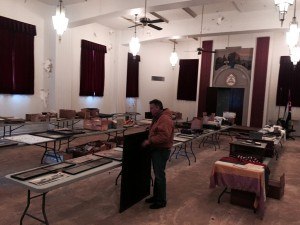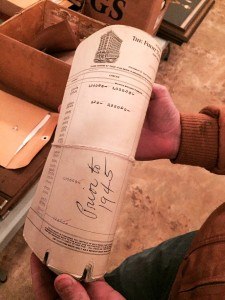Masonic Temple work includes organizing historic documents, artifacts
by February 8, 2016 10:47 am 553 views

Crews inspect and repair mortar joints on the Masonic Temple in downtown Fort Smith.
In addition to the thousands of large and small renovations ongoing at the Masonic Temple in downtown Fort Smith, there are thousands of historic documents and artifacts to catalog in the estimated $4.5 million effort to convert the building into an entertainment venue.
A large meeting room in the building is being used as a staging area for the documents and artifacts. Four long rows of tables hold items that include meeting minutes from different groups that date back to the early days of the Great Depression, correspondence about World War II, numerous photographs, bank records of the various clubs that used the building, special costumes, and notes from leaders of the Order of the Eastern Star.
Lance Beaty, manager of Temple Holdings and president of Beaty Capital Group, said the items provide insight into how people in Fort Smith dealt with the world around them. His plan is to work with archivists, including the Fort Smith Museum of History, to restore and correctly display the materials. Shadowboxes with the items will then be placed around the Temple and frequently changed.
“The idea is that every time you come here you will see another piece of Fort Smith history,” Beaty said. “I think people will be surprised at what is here. I know I was.”
The Masonic Temple in downtown Fort Smith is set to open mid-October – earlier than the previously announced November opening – as a “multipurpose event facility” to provide space for concerts, corporate and civic events, televised viewing of major sporting events, and other uses. In an October 2015 announcement, Beaty said the historic building constructed in 1928 will offer “a one of a kind experience in which to dine, enjoy cocktails, see live performances, hold corporate and civic events, family reunions, charity events, and a myriad of other functions.”

The 3-story building at 200 N. 11th St. has numerous meeting rooms and a theatre capable of seating 900.
While the historic items are interesting, the majority of the work and money is spent finding and repairing “more than 80 years of damage,” Beaty said. For example, every mortar joint must be inspected and repaired when necessary. And because of the building’s historic status, repairs are more extensive than on a traditional job.
Beaty has brought in his older brother, Lawrence, to help with the sensitive renovation work. Lawrence is director and chair of the Energy Systems Technology and Education Center at Idaho State University. He has more than 33 years in the energy industry, including four years as a nuclear reactor control specialist with the U.S. Navy, and a six years as a site manager for GE Power Systems.
Lawrence Beaty said the challenge so far has been in trying to figure out how some structures and fixtures were built or installed.

“You discover something new almost every day,” Lawrence Beaty said. “And some of these (repairs) … will need tools that don’t exist anymore.”
Major renovation work includes waterproofing walls below the dirt, roof repairs, restoring floors, installing an elevator, and making the facility handicap accessible. Working within the mandates required to maintain historic tax credits has been a challenge, but it so far has been a relatively smooth process.
“They’ve been fairly cooperative. We’ve been pleased. They have been flexible and good to work with,” Lance Beaty said.
